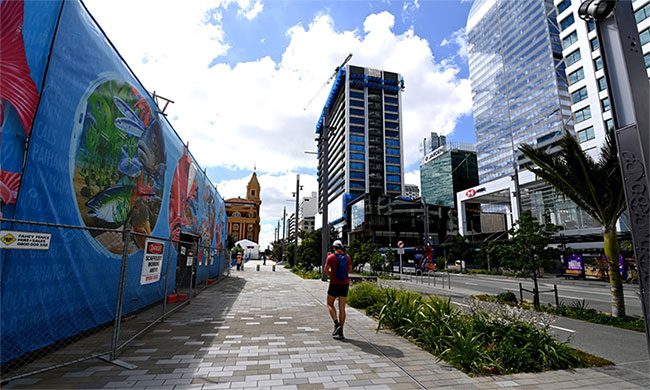Recent findings suggest that researchers around the world may be underestimating the prevalence of microplastics in the air.
Approximately 74 tons of microplastics fell from the atmosphere in Auckland, New Zealand in 2020, equivalent to 3 million plastic bottles.
This alarming information was recently published by scientists from the University of Auckland in the journal Environmental Science & Technology. This study is the first in the world to calculate the total mass of microplastics in the air of a city. Its results indicate that researchers may be underestimating the global prevalence of microplastics in the air.

A corner of Auckland city, New Zealand. (Photo: AFP)
To conduct the research, the team of experts from the University of Auckland collected microplastics that fell on a rooftop in the city center as well as in a garden in the suburbs. Almost all of the microplastics were too small to be seen with the naked eye. Therefore, they identified these particles using fluorescent dye as well as thermal processing methods.
Mr. Joel Rindeaub, the lead author of the study, stated in a press release: “As we looked at smaller and smaller scales, we found more microplastics. This is concerning because the smallest sizes are often the most toxic.”
The team warned that the smallest microplastics are easily inhaled by humans. They can infiltrate cells, cross the bloodstream, and even accumulate in organs such as the liver and brain. Mr. Rindeaub noted: “In the future, we need to accurately quantify the amount of plastic we are inhaling.”
On a square meter per day, the University of Auckland’s research found that the average amount of plastic in the air was 4,885 particles in 2020. This number is significantly higher than the rate of 771 particles found in a 2020 study in London, 275 particles in a 2019 study in Hamburg, and 110 particles in a 2016 study in Paris. The majority of the differences stem from the Auckland study considering smaller size ranges, which were not included in previous studies.
Since mass production began in the 1950s, humans have generated over 8.3 billion tons of plastic, with 79% ending up in landfills or being released into the natural environment. Microplastics are generated from the development of commercial products and the degradation of larger plastics. Once they enter the natural environment, they can contaminate soil, kill wildlife, and infiltrate the food chain.
In Auckland, polyethylene—commonly used in packaging materials—was the most frequently detected substance, followed by polycarbonate, a type of plastic often used in electronic products. The study also noted a relationship between ocean plastic pollution, airborne microplastics in Auckland, and stronger winds from the Hauraki Gulf of New Zealand’s North Island.
Expert Joel Rindeaub commented that this is an important part of the global transportation of microplastics. It may help explain how some microplastics enter the atmosphere and are carried to distant locations, such as New Zealand.
Microplastics are plastic particles smaller than 5 mm that have toxic effects on human and animal cells, but their specific impacts on health are still under investigation. These tiny plastic particles can take decades to fully degrade.



















































